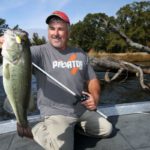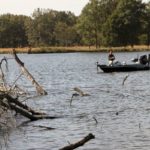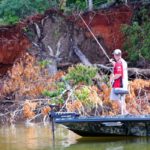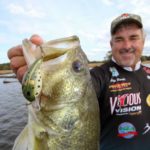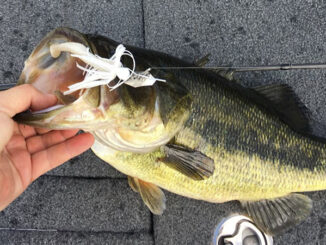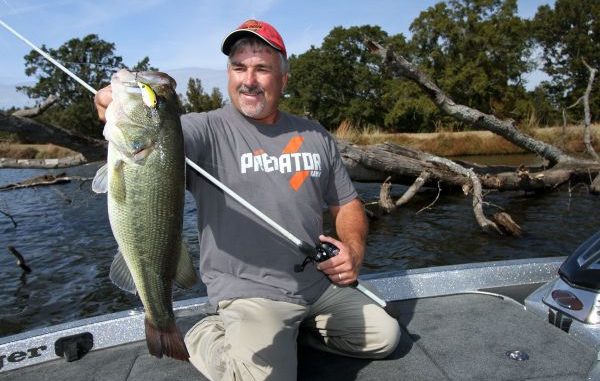
Laydowns are almost guaranteed to hold bass, but what’s the best way to work these fish magnets? These touring pros share their thoughts.
Wood — once a tree, felled by man or nature, it’s now a bass fortress and a structure to be negotiated, encroached upon, invaded by those seeking a face-to-face with said fish.
“I’d rank a laydown as a high-percentage area,” FLW Tour pro Pete Ponds said. “In most fishermen’s minds, it’s commonsense that if you pass a laydown you’re going to fish it.”
Shade, shelter and abundant food sources comprise the common attractions.
That last aspect, Ponds noted, might mean direct supplies of baitfish and bream, as well as all the spiders and insects that fall from laydown branches.
Bigger is definitely better in terms of overall potential, but Ponds won’t pass up a fallen tree sitting all by its lonesome on an otherwise featureless shoreline.
Like a rest stop flanked by long stretches of open interstate, such cover will not go unnoticed — or unutilized.
Gonzales Bassmaster Elite Series pro Greg Hackney said that’s a particularly relevant point when fall finds water levels declining through natural cycles or man-made controls.
Deeper laydowns that retain sufficient habitat can be gold mines, he said.
For those interested in maximizing a laydown’s potential, randomness is a dirty word. As Ponds explained, patience and thoroughness pave the path to success.
“I’ll start on the outer edges, because that’s where the most-aggressive fish will position,” he said. “Then, I’ll work my way in closer to the main trunk of the tree.”
Limb structure varies from tree to tree, but even if you only see a trunk emerging from the water, it’s very likely you have at least a handful of limbs scattered beneath the surface. Just imagine what a live oak, cedar or sweet gum tree looks like, and then use that general image when most of your present structure sits out of sight.
Side-scanning sonar can play a valuable role here, as those subsurface views combined with what you see above the water provide a road map for your laydown approach.
“Pay attention to where the main limbs split to form Y’s,” Ponds said. “Bass like cover and these areas just offer more cover.
Following are some more thoughts on making the most of every laydown.
Positioning
Consider these points as you pick apart a laydown:
• Light and darkness — Sun angle dictates the shade line and, generally, bass prefer the shadows. On colder days, the sun might be what the fish want; fish the conditions, and position yourself accordingly.
• Ripples and waves — Wind tends to position baitfish, and blustery conditions will also influence where the bass sit. Most predators want to be downwind/downcurrent of a structure, so food flows to them.
Also consider that a good blow can stimulate those reaction bites with spinnerbaits, crankbaits and the like.
On the downside, a windy day might complicate boat handling, so beware of spooking the fish with hull slap or an uncontrolled drift.
• Depth of thought — FLW pro Pete Ponds noted that the trunks of most laydowns have a shallow and a deep side, depending on how the tree falls. The latter typically offers the most opportunity.
• The way it lays — Ponds said how lures are dragged through a laydown definitely matters.
“Fish with the grain,” he said. “Think of the (outer branches) as fingers, and take note of which direction they’re facing. If you fish with the grain, you’re less likely to get snagged.
“If you have to go in there (to retrieve a snagged lure) and you bump a limb, you’ll spook every fish on the laydown.”
Bait selection
For picking off perimeter fish, FLW Tour pro Pete Ponds starts a laydown assault with a topwater plug.
Walkers or poppers will do, although the latter tends to shine more when choppy conditions limit a walking bait’s effectiveness.
“As I move in closer, I’ll use a Bandit 200 crankbait because it comes through the cover well,” Ponds said. “From there, I would probably move to the Bandit 250 Ledge to reach those deeper areas.”
In the final phase of his laydown dissection, Ponds targets the main trunk area with a flipping/pitching presentation.
Targeting the area where the tree enters the water — and a few feet in either direction — typically proves productive.
For flipping duties, the compact form of a jig or a Texas-rigged beaver or craw bait works just fine.
But Gonzales touring pro Greg Hackney likes the long, slender profile of a Texas-rigged ribbontail worm. That wavy action slipping through the branches of a laydown or tracing the trunk’s contours can be simply irresistible to lounging bass, he said.
The right approach
FLW pro Pete Ponds stressed the importance of a calculated approach, but he also emphasized boat control.
Just because fish have cover in their laydown fortress does not mean they feel impervious, so you must make very calculating approaches.
“Boat positioning is critical when fishing laydowns because if you come in at the wrong angle and you turn your trolling motor on high to back up or you turn it to the left to get away from the laydown, you have to remember that the backwash (blows out the spot),” Ponds said.
